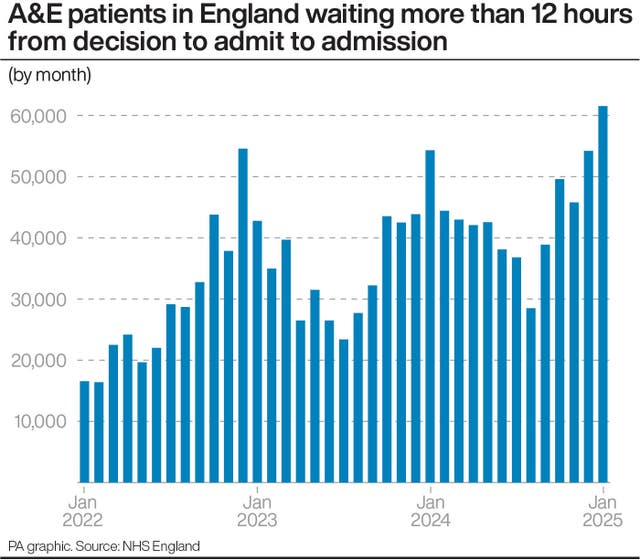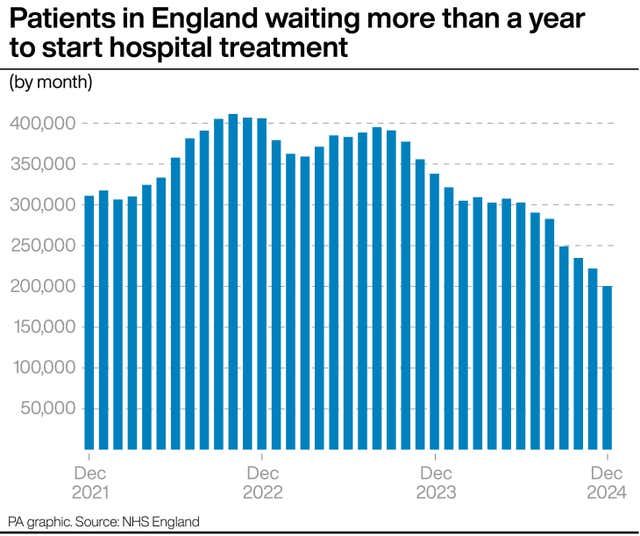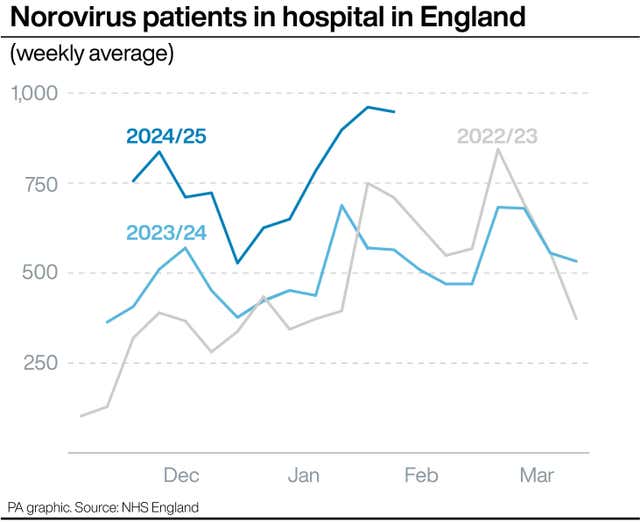Number of patients waiting over 12 hours after A&E admission reaches record high
Experts urged the Government to address issues in social care to tackle delayed discharges.

A record number of people in England waited more than 12 hours after being admitted to A&E before receiving care last month, new figures show.
It comes as delayed discharge for patients deemed fit enough to leave hospital hit another winter high.
Experts urged the Government to address issues in social care to tackle delayed discharges amid warnings that they overwhelm emergency departments and put more strain on an “already overburdened” healthcare system.

Meanwhile, the waiting list for routine hospital treatment in England fell for the fourth consecutive month, with the number of people waiting more than a year for treatment also at its lowest since November 2020.
New figures from NHS England show a record 61,529 people waited more than 12 hours in A&E departments from a decision to admit to actually being admitted in January, up from 54,207 in December.
This surpasses the previous record of 54,573 patients in December 2022.
The number of people waiting at least four hours also rose, although not to a new record, standing at 159,582 in January, up from 154,689 in December.
Dr Adrian Boyle, president of the Royal College of Emergency Medicine, said long A&E stays are undignified, uncomfortable and dangerous for patients.
“The highest ever number of patients experiencing stays of 12 hours or more before an inpatient bed can be found for them is nothing short of a catastrophe,” he added.
“In 2023, we calculated that there were almost 14,000 deaths associated with these long stays – and just last month, the ONS again evidenced the serious risk that patients are exposed to when they experience them. We believe that the figures for 2024 will be worse.
“And, as has been so clearly evidenced, these waits are often endured on trolleys in corridors or cupboards, or chairs in waiting rooms. The focus has to shift to addressing these stays.”
The figures also showed an average of 14,087 hospital beds per day were filled last week in England with patients who were fit to be discharged.

This is up from 13,776 the previous week and is the highest number so far this winter.
On average, 41% of patients ready to leave hospital last week were actually discharged each day.
Saffron Cordery, interim chief executive NHS Providers, said this winter has been the “toughest” that many trust leaders can remember.
“Wards are full of thousands of patients ready to be discharged but can’t be, often due to a lack of community NHS or social care capacity,” she added.
“Last week, one in seven beds were filled by these patients.
“This logjam has been a challenge for years, we need a long-term solution. It has a serious knock-on effect, with a record number of patients waiting to be admitted through A&E.”
The Royal College of Physicians (RCP) also warned that delayed discharges are overwhelming emergency departments.
The college’s clinical vice president Dr John Dean said: “This is a systemic failure that places intolerable pressure on the NHS.
“Delayed discharges overwhelm emergency departments, force the cancellation of planned treatments and cause patients unnecessary distress and deterioration in their health.
“The impact ripples across the entire healthcare system — from paramedics waiting with patients in ambulances to doctors and nurses struggling to find space for those in urgent need.”
Professor Peter Friend, vice president of the Royal College of Surgeons of England, warned that “pressures on hospitals at this time of year are immense”.
“They need urgent support to address delayed discharges,” he added.

“Patients are stuck in hospital beds for days on end, with staff wading through the quicksand of a disjointed and underfunded system, that only adds more strain to our already overburdened healthcare services.”
Elsewhere, waiting lists dropped for the fourth consecutive month to their lowest figure since April 2023.
An estimated 7.46 million treatments were waiting to be carried out at the end of December in England, relating to 6.24 million patients – down from 7.48 million treatments and 6.28 million patients at the end of November.
The number of people waiting more than 52 weeks to start routine treatment stood at 200,375 at the end of December, down from 221,889 at the end of November and the lowest number since November 2020.
This is the equivalent of 2.7% of patients on the waiting list, with the Government and NHS England aiming to get the figure to less than 1% by March 2026.
Meanwhile, there were 2,059 patients waiting more than 18 months to start routine treatment at the end of December, up very slightly from 2,051 in November, while the number of patients waiting more than 65 weeks dropped to 15,568 from 16,904.
Professor Julian Redhead, NHS England’s national clinical director for urgent and emergency care, said the figures show “how innovations and the hard work of staff are now delivering consistent progress in bringing down the backlog”.
“This post-pandemic period is potentially the hardest the NHS has ever managed and that has certainly been true this winter with soaring levels of viruses, high bed occupancy and difficulties discharging patients – with last week seeing 14,000 beds taken up each day by patients who were medically fit for discharge,” he added.
“Despite that storm of pressure in January, A&E and ambulance waiting times were improved on both the month and year before, and this year we will continue work to improve patient flow across hospitals throughout the year, to ensure that we’re in a better position for next winter.”
Health Secretary Wes Streeting said: “As we work to end the misery of people left stranded on NHS waiting lists, we will also continue to address the issues facing our A&E departments.
“Annual winter pressures should not automatically lead to an annual winter crisis and we will soon publish our plan to improve urgent and emergency care services, so the NHS can be there for everyone when they need it, once again.”





